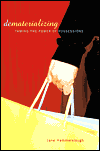
If you've caught yourself looking at a recent purchase, shaking your head and asking yourself, "What was I thinking?" you need to read this book. In each chapter of her book, Hammerslough explores a psychological need that people may try to fill by acquiring things, and the ways in which marketing media exploit that need. She also gives strategies for analyzing advertising and other forms of media manipulation, as well as suggesting more active ways to deal with your needs than simply trying to buy a solution. Along the way, she provides interesting information on social trends in consumerism and their history, as well as plenty of anecdotes to illustrate the situations she describes.
Refreshingly, Hammerslough does not shrill at the reader to cut up her credit cards, get rid of the clutter, and live a life of voluntary simplicity. Although she advocates living within your means, and wouldn't object if you got rid of some things, she also respects individual differences, both in incomes and preferences. For example, while one person might be happy with a wardrobe of ten mix and match pieces, another may need many more outfits, each complete with its own accessories. A house that seems "cluttered" to one person may be "cozy" to another. What Hammerslough advocates is a sort of "conscious consumerism." The desire for possessions, and possessions themselves are neither good nor bad - it is the owner's attitude towards them, and how much space they occupy in her life, not her house, that makes the difference.
Hammerslough's purpose in writing the book seems to be to help the reader begin to understand why she buys and owns the things she does. What the reader does with the information is, of course, up to herself, but hopefully it will lead, over time, to fewer emotional purchases, less money wasted, and more satisfaction with the things that she does own.
~review by Jackie Gorman
Author: Jane Hammerslough
Perseus Publishing, 2001
pp. 288, $25
